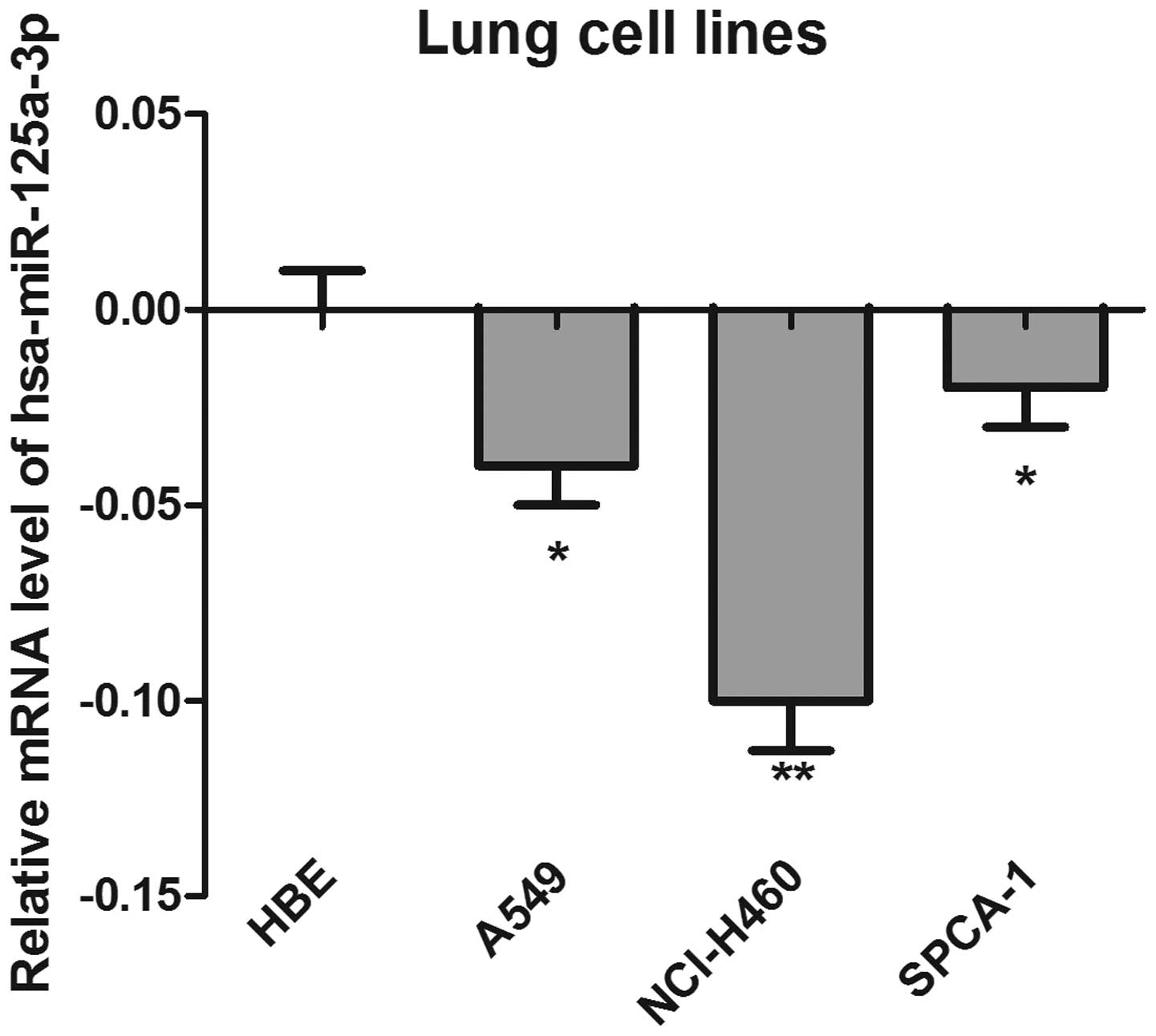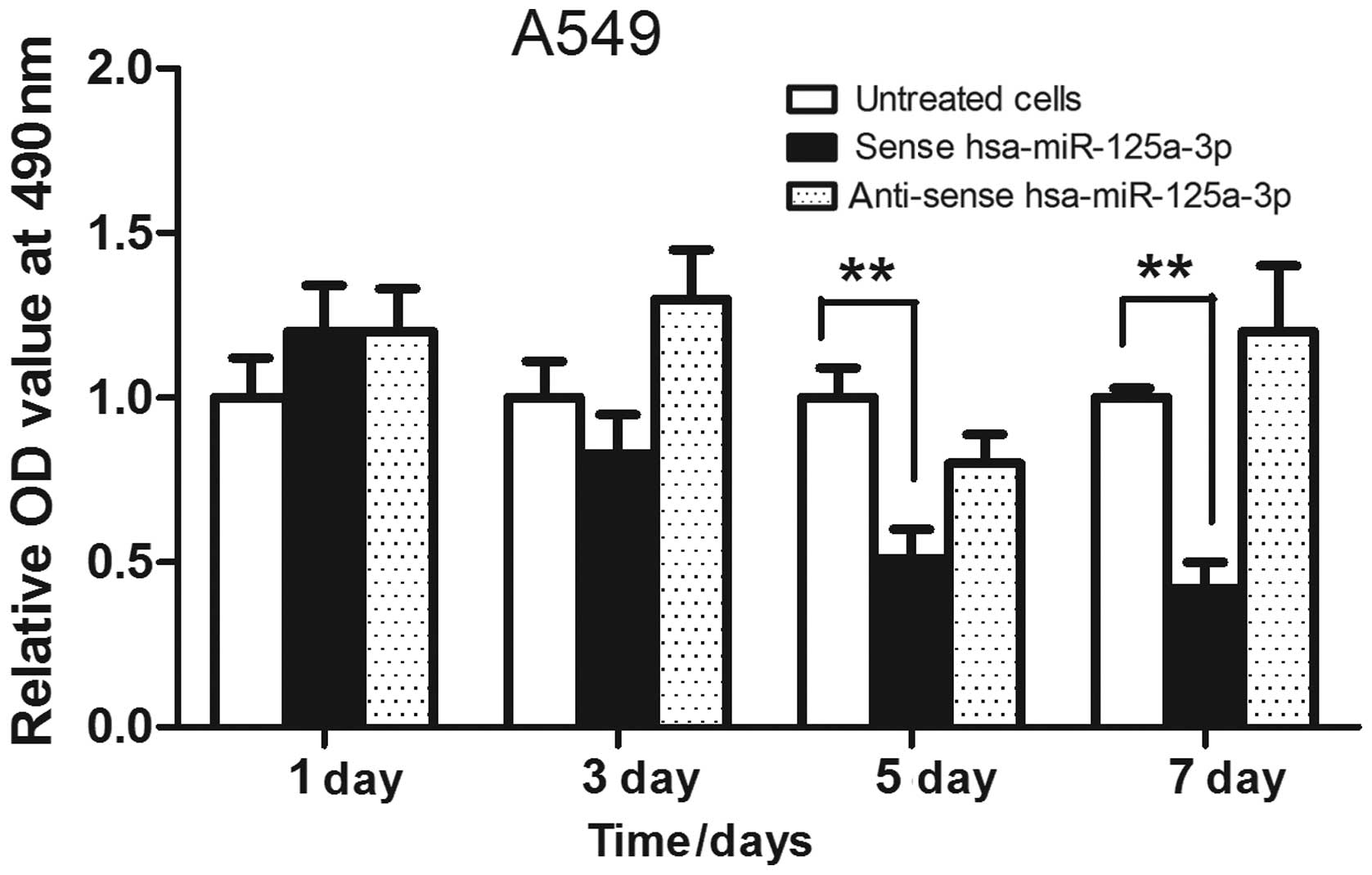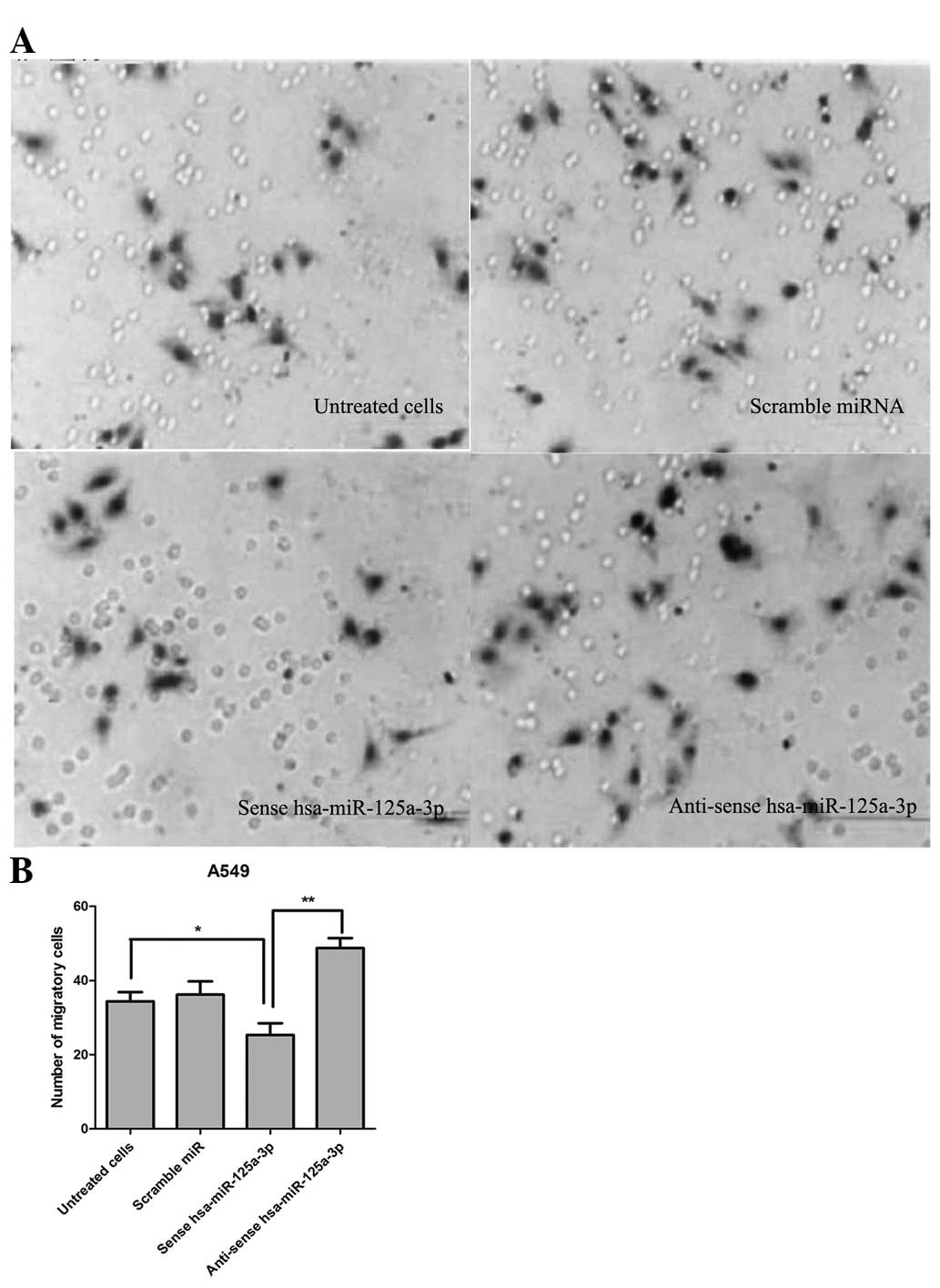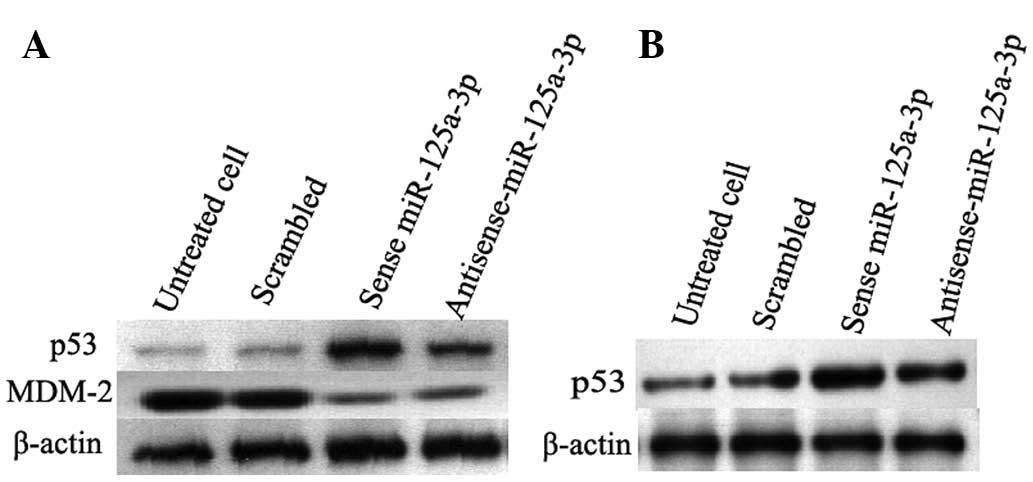|
1
|
Xu X, Yang X, Xing C, Zhang S and Cao J:
miRNA: The nemesis of gastric cancer (Review). Oncol Lett.
6:631–641. 2013.PubMed/NCBI
|
|
2
|
Cai Y, Yu X, Hu S and Yu J: A brief review
on the mechanisms of miRNA regulation. Genomics Proteomics
Bioinformatics. 7:147–154. 2009. View Article : Google Scholar
|
|
3
|
Lodewijk L, Prins AM, Kist JW, et al: The
value of miRNA in diagnosing thyroid cancer: a systematic review.
Cancer Biomark. 11:229–238. 2012.PubMed/NCBI
|
|
4
|
Srivastava K and Srivastava A:
Comprehensive review of genetic association studies and
meta-analyses on miRNA polymorphisms and cancer risk. PLoS ONE.
7:e509662012. View Article : Google Scholar : PubMed/NCBI
|
|
5
|
Scott GK, Goga A, Bhaumik D, Berger CE,
Sullivan CS and Benz CC: Coordinate suppression of ERBB2 and ERBB3
by enforced expression of micro-RNA miR-125a or miR-125b. J Biol
Chem. 282:1479–1486. 2007. View Article : Google Scholar
|
|
6
|
Jiang L, Zhang Q, Chang H, Qiu X and Wang
E: hsa-miR-125a-5p enhances invasion in non-small cell lung
carcinoma cell lines by upregulating rock-1. Zhongguo Fei Ai Za
Zhi. 12:1069–1073. 2009.In Chinese.
|
|
7
|
Huang B, Luo W, Sun L, et al:
MiRNA-125a-3p is a negative regulator of the RhoA-actomyosin
pathway in A549 cells. Int J Oncol. 42:1734–1742. 2013.PubMed/NCBI
|
|
8
|
Li X, Sundquist J, Zöller B and Sundquist
K: Neighborhood deprivation and lung cancer incidence and
mortality: a multilevel analysis from sweden. J Thorac Oncol.
10:256–263. 2015. View Article : Google Scholar
|
|
9
|
Janković M, Samarzija M, Jakopović M,
Kulis T and Znaor A: Trends in lung cancer incidence and mortality
in Croatia, 1988–2008. Croat Med J. 53:93–99. 2012. View Article : Google Scholar
|
|
10
|
Ondrusova M, Muzik J, Hunakova L, et al:
Trends in the lung cancer incidence and mortality in the Slovak and
Czech Republics in the contexts of an international comparison.
Clin Transl Oncol. 659–666. 2012. View Article : Google Scholar : PubMed/NCBI
|
|
11
|
Song Y and Yao Y: Lung cancer
screening:review and prospect. Zhonghua Jie He He Hu Xi Za Zhi.
37:164–166. 2014.In Chinese. PubMed/NCBI
|
|
12
|
Pendharkar D, Ausekar BV and Gupta S:
Molecular biology of lung cancer-a review. Indian J Surg Oncol.
4:120–124. 2013. View Article : Google Scholar :
|
|
13
|
Di JZ, Peng JY and Wang ZG: Prevalence,
clinicopathological characteristics, treatment, and prognosis of
intestinal metastasis of primary lung cancer: A comprehensive
review. Surg Oncol. 23:72–80. 2014. View Article : Google Scholar : PubMed/NCBI
|
|
14
|
Thunnissen E, van der Oord K and den
Bakker M: Prognostic and predictive biomarkers in lung cancer. A
review Virchows Arch. 464:347–358. 2014. View Article : Google Scholar
|
|
15
|
Kumar S, Mohan A and Guleria R: Prognostic
implications of circulating anti-p53 antibodies in lung cancer - a
review. Eur J Cancer Care (Engl). 18:248–254. 2009. View Article : Google Scholar
|
|
16
|
Bergqvist M: Radiosensitivity in lung
cancer with focus on p53: a review based on a doctoral thesis. Ups
J Med Sci. 108:87–127. 2003.PubMed/NCBI
|
|
17
|
Wang AL, Liu ZX, Li G and Zhang LW:
Expression and significance of P53 protein and MDM-2 protein in
human gliomas. Chin Med J (Engl). 124:2530–2533. 2011.
|
|
18
|
Asher G, Lotem J, Sachs L, Kahana C and
Shaul Y: Mdm-2 and ubiquitin-independent p53 proteasomal
degradation regulated by NQO1. Proc Natl Acad Sci USA.
99:13125–13130. 2002. View Article : Google Scholar : PubMed/NCBI
|
|
19
|
Jabbur JR, Tabor AD, Cheng X, et al: Mdm-2
binding and TAF(II)31 recruitment is regulated by hydrogen bond
disruption between the p53 residues Thr18 and Asp21. Oncogene.
21:7100–7113. 2002. View Article : Google Scholar : PubMed/NCBI
|
|
20
|
Almog N, Milyavsky M, Stambolsky P,
Falcovitz A, Goldfinger N and Rotter V: The role of the C' terminus
of murine p53 in the p53/mdm-2 regulatory loop. Carcinogenesis.
22:779–785. 2001. View Article : Google Scholar : PubMed/NCBI
|
|
21
|
Kondo I, Iida S, Takagi Y and Sugihara K:
MDM2 mRNA expression in the p53 pathway may predict the potential
of invasion and liver metastasis in colorectal cancer. Dis Colon
Rectum. 51:1395–1402. 2008. View Article : Google Scholar : PubMed/NCBI
|
|
22
|
Nishitani H, Sugimoto N, Roukos V, et al:
Two E3 ubiquitin ligases, SCF-Skp2 and DDB1-Cul4, target human Cdt1
for proteolysis. EMBO J. 25:1126–1136. 2006. View Article : Google Scholar : PubMed/NCBI
|
|
23
|
Peng L, Xu Z, Zhou Y, Yang T, Liang ZQ and
Zhang M: Effect of rosiglitazone on cells cycle, apoptosis and
expression of Skp2 and p27Kip1 in hepatocellular carcinoma cell
line. Zhonghua Gan Zang Bing Za Zhi. 18:148–149. 2010.In Chinese.
PubMed/NCBI
|
|
24
|
Schulman BA, Carrano AC, Jeffrey PD, et
al: Insights into SCF ubiquitin ligases from the structure of the
Skp1-Skp2 complex. Nature. 408:381–386. 2000. View Article : Google Scholar : PubMed/NCBI
|
|
25
|
Krishan A: Rapid flow cytofluorometric
analysis of mammalian cell cycle by propidium iodide staining. J
Cell Biol. 66:188–193. 1975. View Article : Google Scholar : PubMed/NCBI
|
|
26
|
Buchegger F, Dupertuis YM and
Perillo-Adamer F: A pitfall of propidium iodide staining in
fluorescence-activated cell sorting cell cycle analysis? Cancer
Res. 67:5576–5577. 2007. View Article : Google Scholar : PubMed/NCBI
|
|
27
|
Rüster B, Grace B, Seitz O, Seifried E and
Henschler R: Induction and detection of human mesenchymal stem cell
migration in the 48-well reusable transwell assay. Stem Cells Dev.
14:231–235. 2005. View Article : Google Scholar : PubMed/NCBI
|
|
28
|
Primiceri E, Chiriacò MS, Dioguardi F, et
al: Automatic transwell assay by an EIS cell chip to monitor cell
migration. Lab Chip. 11:4081–4086. 2011. View Article : Google Scholar : PubMed/NCBI
|
|
29
|
Tilghman SL, Rhodes LV, Bratton MR, et al:
Phytoalexins, miRNAs and breast cancer: a review of
phytochemical-mediated miRNA regulation in breast cancer. J Health
Care Poor Underserved. 24(Suppl): 36–46. 2013. View Article : Google Scholar : PubMed/NCBI
|
|
30
|
Kim JK, Noh JH, Jung KH, et al: Sirtuin7
oncogenic potential in human hepatocellular carcinoma and its
regulation by the tumor suppressors MiR-125a-5p and MiR-125b.
Hepatology. 57:1055–1067. 2013. View Article : Google Scholar
|
|
31
|
Jiang L, Huang Q, Chang J, Wang E and Qiu
X: MicroRNA HSA-miR-125a-5p induces apoptosis by activating p53 in
lung cancer cells. Exp Lung Res. 37:387–398. 2011. View Article : Google Scholar : PubMed/NCBI
|
|
32
|
Bi Q, Tang S, Xia L, et al: Ectopic
expression of MiR-125a inhibits the proliferation and metastasis of
hepatocellular carcinoma by targeting MMP11 and VEGF. PLoS ONE.
7:e401692012. View Article : Google Scholar : PubMed/NCBI
|
|
33
|
Hashiguchi Y, Nishida N, Mimori K, et al:
Down-regulation of miR-125a-3p in human gastric cancer and its
clinicopathological significance. Int J Oncol. 40:1477–1482.
2012.PubMed/NCBI
|
|
34
|
Collins J, Noble S, Chester J, Coles B and
Byrne A: The assessment and impact of sarcopenia in lung cancer: a
systematic literature review. BMJ Open. 4:e0036972014. View Article : Google Scholar : PubMed/NCBI
|














